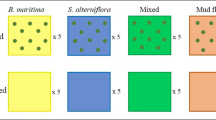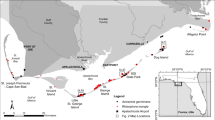Abstract
While saltwort (Batis maritima L.) is common in the fringe mangrove forests of southwest Florida, its role in regeneration of degraded mangrove communities is not known. Given the potential encroachment and subsequent degradation of mangrove communities by sea-level rise, it is important to quantify the effect of early-colonizing vegetation to early mangrove seedling survival. A greater number of mangrove seedlings were observed in existing B. maritima patches compared to surrounding mudflats. A planting experiment was designed to determine whether B. maritima was responsible for the observed pattern. Black mangrove (Avicennia germinans L.) seedlings, raised in a nursery, were planted in previously established B. maritima patches and on mudflats with and without nursery-raised B. maritima. There was significantly lower mortality of A. germinans seedlings when planted in existing B. maritima patches (69%), compared to seedlings planted on the mudflats (93%), demonstrating that existing B. maritima improved A. germinans seedling survival. Nursery-raised B. maritima had lower mortality on open mudflats (28%), suggesting that it can tolerate conditions, which make it an early colonizer of newly available habitats. The primary mechanism proposed for improving seedling success is a slight increase in elevation provided by the dense root network of established B. maritima. These findings have implications for scientists and managers anticipating the response of mangroves to sea-level rise.
Similar content being viewed by others
References
Begon M., Harper J. L. and Townsend C. R. (1996). Ecology. Blackwell Scientific, Australia, 1068
Bertness M. D. (1991). Interspecific interactions among high marsh perennials in a New England salt marsh. Ecology 72: 125–137
Connell J. H. and Slayter R. O. (1977). Mechanisms of succession in natural communities and their role in community stability and organization. American Naturalist 111: 1119–1144
Crewz D. W. and Lewis R. R. (1991). An Evaluation of Historical Attempts to Establish Emergent Vegetation in Marine wetlands in Florida. Florida Sea Grant Technical Publication No. 60. Florida Sea Grant College, Gainesville, FL
Duke N. C., Ball M. C. and Ellison J. C. (1998). Factors influencing biodiversity and distributional gradients in mangroves. Global Ecology and Biogeography Letters 7: 27–47
Dytham C. (2003). Choosing and using Statistics: A Biologists Guide. Blackwell Scientific, Victoria, Australia, 246
Ellison J. C. (1993). Mangrove retreat with rising sea-level, Bermuda. Estuarine, Coastal and Shelf Science 37: 75–87
Ellison A. M. and Farnsworth E. J. (2001). Mangrove communities. In: Bertness, M. D., Gaines, S. D. and Hay, M. E. (eds) Marine Community Ecology, pp 550. Sinauer, MA
Lewis R. R. (2005). Ecological engineering for successful management and restoration of mangrove forests. Ecological Engineering 24: 403–418
McKee K. L. (1995). Seedling recruitment patterns in a Belizean mangrove forest: effects of establishment ability and physico-chemical factors. Oecologia 101: 448–460
Odum W. E. and McIvor C. C. (1982). The Ecology of the Mangroves of South Florida: A Community Profile. U.S. Fish and Wildlife Service, Office of Biological Services, Washington, DC, 144
Pezeshki S. R., DeLaune R. D. and Meeder J. F. (1997). Carbon assimilation and biomass partitioning in Avicennia germinans and Rhizophora mangle seedlings in response to soil redox conditions. Environmental and Experimental Botany 37: 161–171
Proffitt C. E. and Devlin D. J. (2005). Long-term growth and succession in restored and natural mangrove forests in southwestern Florida. Wetlands Ecology and Management 13: 531–551
Semeniuk V. (1994). Predicting the effect of sea-level rise on mangroves in northwestern Australia. Journal of Coastal Research 10: 1050–1076
(1987). Effects of light and intertidal position on seedling survival and growth in tropical tidal forests. Journal of Experimental Marine Biology and Ecology 110: 133–146
Sokal R. R. and Rohlf F. J. (1991). Biometry. Freeman, New York, 829
Wolanski E., Mazda Y. and Ridd P. (1992). Mangrove hydrodynamics. In: Robertson, A. I. and Alongi, D. M. (eds) Tropical Mangrove Ecosystems, pp 436–462. American Geophysical Union, Washington, DC
Zimmerman C. F., French T. D. and Montgomery J. R. (1981). Transplanting and survival of the seagrass Halodule wrightii under controlled conditions. Northeast Gulf Science 4: 131–136
Author information
Authors and Affiliations
Corresponding author
Rights and permissions
About this article
Cite this article
Milbrandt, E.C., Tinsley, M.N. The role of saltwort (Batis maritima L.) in regeneration of degraded mangrove forests. Hydrobiologia 568, 369–377 (2006). https://doi.org/10.1007/s10750-006-0203-3
Received:
Revised:
Accepted:
Published:
Issue Date:
DOI: https://doi.org/10.1007/s10750-006-0203-3




